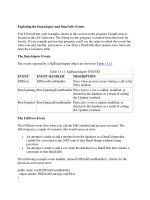HANDLING MOUSE AND KEYBOARD EVENTS docx
Bạn đang xem bản rút gọn của tài liệu. Xem và tải ngay bản đầy đủ của tài liệu tại đây (261.67 KB, 17 trang )
1
© 2001-2003 Marty Hall, Larry Brown
Web
core
programming
Handling Mouse and
Keyboard Events
Handling Mouse and Keyboard Events2
www.corewebprogramming.com
Agenda
•
General event-handling strategy
• Handling events with separate listeners
• Handling events by implementing interfaces
• Handling events with named inner classes
• Handling events with anonymous inner
classes
• The standard AWT listener types
• Subtleties with mouse events
• Examples
Handling Mouse and Keyboard Events3
www.corewebprogramming.com
General Strategy
•
Determine what type of listener is of interest
– 11 standard AWT listener types, described on later slide.
• ActionListener, AdjustmentListener,
ComponentListener, ContainerListener,
FocusListener, ItemListener, KeyListener,
MouseListener, MouseMotionListener, TextListener,
WindowListener
• Define a class of that type
– Implement interface (KeyListener, MouseListener, etc.)
– Extend class (KeyAdapter, MouseAdapter, etc.)
• Register an object of your listener class
with the window
– w.addXxxListener(new MyListenerClass());
• E.g., addKeyListener, addMouseListener
Handling Mouse and Keyboard Events4
www.corewebprogramming.com
Handling Events with a
Separate Listener: Simple Case
•
Listener does not need to call any methods
of the window to which it is attached
import java.applet.Applet;
import java.awt.*;
public class ClickReporter extends Applet {
public void init() {
setBackground(Color.yellow);
addMouseListener(new ClickListener());
}
}
Handling Mouse and Keyboard Events5
www.corewebprogramming.com
Separate Listener: Simple Case
(Continued)
import java.awt.event.*;
public class ClickListener
extends MouseAdapter {
public void mousePressed(MouseEvent event) {
System.out.println("Mouse pressed at (" +
event.getX() + "," +
event.getY() + ").");
}
}
Handling Mouse and Keyboard Events6
www.corewebprogramming.com
Generalizing Simple Case
•
What if ClickListener wants to draw a circle
wherever mouse is clicked?
• Why can’t it just call getGraphics to get a
Graphics object with which to draw?
• General solution:
– Call event.getSource to obtain a reference to window or
GUI component from which event originated
– Cast result to type of interest
– Call methods on that reference
Handling Mouse and Keyboard Events7
www.corewebprogramming.com
Handling Events with Separate
Listener: General Case
import java.applet.Applet;
import java.awt.*;
public class CircleDrawer1 extends Applet {
public void init() {
setForeground(Color.blue);
addMouseListener(new CircleListener());
}
}
Handling Mouse and Keyboard Events8
www.corewebprogramming.com
Separate Listener: General
Case (Continued)
import java.applet.Applet;
import java.awt.*;
import java.awt.event.*;
public class CircleListener extends MouseAdapter {
private int radius = 25;
public void mousePressed(MouseEvent event) {
Applet app = (Applet)event.getSource();
Graphics g = app.getGraphics();
g.fillOval(event.getX()-radius,
event.getY()-radius,
2*radius,
2*radius);
}
}
Handling Mouse and Keyboard Events9
www.corewebprogramming.com
Separate Listener: General
Case (Results)
Handling Mouse and Keyboard Events10
www.corewebprogramming.com
Case 2: Implementing a
Listener Interface
import java.applet.Applet;
import java.awt.*;
import java.awt.event.*;
public class CircleDrawer2 extends Applet
implements MouseListener {
private int radius = 25;
public void init() {
setForeground(Color.blue);
addMouseListener(this);
}
Handling Mouse and Keyboard Events11
www.corewebprogramming.com
Implementing a Listener
Interface (Continued)
public void mouseEntered(MouseEvent event) {}
public void
mouseExited(MouseEvent event) {}
public void mouseReleased(MouseEvent event) {}
public void
mouseClicked(MouseEvent event) {}
public void mousePressed(MouseEvent event) {
Graphics g = getGraphics();
g.fillOval(event.getX()-radius,
event.getY()-radius,
2*radius,
2*radius);
}
}
Handling Mouse and Keyboard Events12
www.corewebprogramming.com
Case 3: Named Inner Classes
import java.applet.Applet;
import java.awt.*;
import java.awt.event.*;
public class CircleDrawer3 extends Applet {
public void init() {
setForeground(Color.blue);
addMouseListener(new CircleListener());
}
Handling Mouse and Keyboard Events13
www.corewebprogramming.com
Named Inner Classes
(Continued)
•
Note: still part of class from previous slide
private class CircleListener
extends MouseAdapter {
private int radius = 25;
public void mousePressed(MouseEvent event) {
Graphics g = getGraphics();
g.fillOval(event.getX()-radius,
event.getY()-radius,
2*radius,
2*radius);
}
}
}
Handling Mouse and Keyboard Events14
www.corewebprogramming.com
Case 4: Anonymous Inner
Classes
public class CircleDrawer4 extends Applet {
public void init() {
setForeground(Color.blue);
addMouseListener
(new MouseAdapter() {
private int radius = 25;
public void mousePressed(MouseEvent event) {
Graphics g = getGraphics();
g.fillOval(event.getX()-radius,
event.getY()-radius,
2*radius,
2*radius);
}
});
}
}
Handling Mouse and Keyboard Events15
www.corewebprogramming.com
Event Handling Strategies:
Pros and Cons
•
Separate Listener
– Advantages
• Can extend adapter and thus ignore unused methods
• Separate class easier to manage
– Disadvantage
• Need extra step to call methods in main window
• Main window that implements interface
– Advantage
• No extra steps needed to call methods in main
window
– Disadvantage
• Must implement methods you might not care about
Handling Mouse and Keyboard Events16
www.corewebprogramming.com
Event Handling Strategies:
Pros and Cons (Continued)
•
Named inner class
– Advantages
• Can extend adapter and thus ignore unused methods
• No extra steps needed to call methods in main
window
– Disadvantage
• A bit harder to understand
• Anonymous inner class
– Advantages
• Same as named inner classes
• Even shorter
– Disadvantage
• Much harder to understand
Handling Mouse and Keyboard Events17
www.corewebprogramming.com
Standard AWT Event Listeners
(Summary)
Adapter Class
Listener (If Any) Registration Method
ActionListener addActionListener
AdjustmentListe ner addAdjustmentLis te ne r
Compone ntLis tener Compone ntAdapter addCompone ntListe ne r
Containe rLis te ne r Containe rAdapte r addContaine rLis te ne r
FocusListe ne r FocusAdapte r addFocus Liste ne r
ItemListener addItemListener
KeyListener KeyAdapter addKeyListener
MouseListe ne r MouseAdapter addMous e Liste ne r
MouseMotionListe ne r MouseMotionAdapte r addMous e MotionLis tener
TextListe ner addTextListe ner
WindowListe ne r WindowAdapte r addWindowLis te ner
Handling Mouse and Keyboard Events18
www.corewebprogramming.com
Standard AWT Event Listeners
(Details)
•
ActionListener
– Handles buttons and a few other actions
• actionPerformed(ActionEvent event)
• AdjustmentListener
– Applies to scrolling
• adjustmentValueChanged(AdjustmentEvent event)
• ComponentListener
– Handles moving/resizing/hiding GUI objects
• componentResized(ComponentEvent event)
• componentMoved (ComponentEvent event)
• componentShown(ComponentEvent event)
• componentHidden(ComponentEvent event)
10
Handling Mouse and Keyboard Events19
www.corewebprogramming.com
Standard AWT Event Listeners
(Details Continued)
•
ContainerListener
– Triggered when window adds/removes GUI controls
• componentAdded(ContainerEvent event)
• componentRemoved(ContainerEvent event)
• FocusListener
– Detects when controls get/lose keyboard focus
• focusGained(FocusEvent event)
• focusLost(FocusEvent event)
Handling Mouse and Keyboard Events20
www.corewebprogramming.com
Standard AWT Event Listeners
(Details Continued)
•
ItemListener
– Handles selections in lists, checkboxes, etc.
• itemStateChanged(ItemEvent event)
• KeyListener
– Detects keyboard events
• keyPressed(KeyEvent event) any key pressed
down
• keyReleased(KeyEvent event) any key released
• keyTyped(KeyEvent event) key for printable char
released
11
Handling Mouse and Keyboard Events21
www.corewebprogramming.com
Standard AWT Event Listeners
(Details Continued)
• MouseListener
– Applies to basic mouse events
• mouseEntered(MouseEvent event)
• mouseExited(MouseEvent event)
• mousePressed(MouseEvent event)
• mouseReleased(MouseEvent event)
• mouseClicked(MouseEvent event) Release without
drag
– Applies on release if no movement since press
• MouseMotionListener
– Handles mouse movement
• mouseMoved(MouseEvent event)
• mouseDragged(MouseEvent event)
Handling Mouse and Keyboard Events22
www.corewebprogramming.com
Standard AWT Event Listeners
(Details Continued)
•
TextListener
– Applies to textfields and text areas
• textValueChanged(TextEvent event)
• WindowListener
– Handles high-level window events
• windowOpened, windowClosing, windowClosed,
windowIconified, windowDeiconified,
windowActivated, windowDeactivated
– windowClosing particularly useful
12
Handling Mouse and Keyboard Events23
www.corewebprogramming.com
Mouse Events: Details
•
MouseListener and MouseMotionListener
share event types
• Location of clicks
– event.getX() and event.getY()
• Double clicks
– Determined by OS, not by programmer
– Call event.getClickCount()
• Distinguishing mouse buttons
– Call event.getModifiers() and compare to
MouseEvent.Button2_MASK for a middle click and
MouseEvent.Button3_MASK for right click.
– Can also trap Shift-click, Alt-click, etc.
Handling Mouse and Keyboard Events24
www.corewebprogramming.com
Simple Example: Spelling-
Correcting Textfield
•
KeyListener corrects spelling during typing
• ActionListener completes word on ENTER
• FocusListener gives subliminal hints
13
Handling Mouse and Keyboard Events25
www.corewebprogramming.com
Example: Simple Whiteboard
import java.applet.Applet;
import java.awt.*;
import java.awt.event.*;
public class SimpleWhiteboard extends Applet {
protected int lastX=0, lastY=0;
public void init() {
setBackground(Color.white);
setForeground(Color.blue);
addMouseListener(new PositionRecorder());
addMouseMotionListener(new LineDrawer());
}
protected void record(int x, int y) {
lastX = x; lastY = y;
}
Handling Mouse and Keyboard Events26
www.corewebprogramming.com
Simple Whiteboard (Continued)
private class PositionRecorder extends MouseAdapter {
public void mouseEntered(MouseEvent event) {
requestFocus(); // Plan ahead for typing
record(event.getX(), event.getY());
}
public void mousePressed(MouseEvent event) {
record(event.getX(), event.getY());
}
}
14
Handling Mouse and Keyboard Events27
www.corewebprogramming.com
Simple Whiteboard (Continued)
private class LineDrawer extends MouseMotionAdapter {
public void mouseDragged(MouseEvent event) {
int x = event.getX();
int y = event.getY();
Graphics g = getGraphics();
g.drawLine(lastX, lastY, x, y);
record(x, y);
}
}
}
Handling Mouse and Keyboard Events28
www.corewebprogramming.com
Simple Whiteboard (Results)
15
Handling Mouse and Keyboard Events29
www.corewebprogramming.com
Whiteboard: Adding Keyboard
Events
import java.applet.Applet;
import java.awt.*;
import java.awt.event.*;
public class Whiteboard extends SimpleWhiteboard {
protected FontMetrics fm;
public void init() {
super.init();
Font font = new Font("Serif", Font.BOLD, 20);
setFont(font);
fm = getFontMetrics(font);
addKeyListener(new CharDrawer());
}
Handling Mouse and Keyboard Events30
www.corewebprogramming.com
Whiteboard (Continued)
private class CharDrawer extends KeyAdapter {
// When user types a printable character,
// draw it and shift position rightwards.
public void keyTyped(KeyEvent event) {
String s = String.valueOf(event.getKeyChar());
getGraphics().drawString(s, lastX, lastY);
record(lastX + fm.stringWidth(s), lastY);
}
}
}
16
Handling Mouse and Keyboard Events31
www.corewebprogramming.com
Whiteboard (Results)
Handling Mouse and Keyboard Events32
www.corewebprogramming.com
Summary
•
General strategy
– Determine what type of listener is of interest
• Check table of standard types
– Define a class of that type
• Extend adapter separately, implement interface,
extend adapter in named inner class, extend adapter
in anonymous inner class
– Register an object of your listener class with the window
• Call addXxxListener
• Understanding listeners
– Methods give specific behavior.
• Arguments to methods are of type XxxEvent
– Methods in MouseEvent of particular interest
17
33
© 2001-2003 Marty Hall, Larry Brown
Web
core
programming
Questions?
Handling Mouse and Keyboard Events34
www.corewebprogramming.com
Preview
•
Whiteboard had freehand drawing only
– Need GUI controls to allow selection of other drawing
methods
• Whiteboard had only “temporary” drawing
– Covering and reexposing window clears drawing
– After cover multithreading, we’ll see solutions to this
problem
• Most general is double buffering
• Whiteboard was “unshared”
– Need network programming capabilities so that two
different whiteboards can communicate with each other









